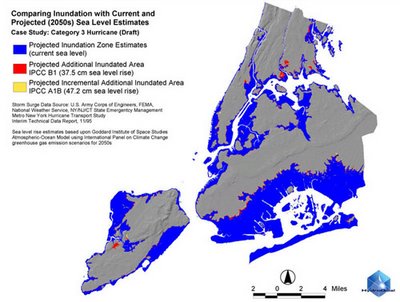We Dodged the Hurricane Bullet This Year, But Dig This....

Sure, hurricane season officially runs through Nov. 30, but we're more likely to get hit by snow than a hurricane between now and then. All of which makes the dire warnings about how New York City was ripe to get slammed by a hurricane and submerged seem like alarmism. Or not. The fact that there were only nine named Atlantic storms this year and none that hit the mainland U.S. is being chalked up to an El Nino that has developed faster than expected.
In other words, wait until next year. Or, the year after, depending on how El Nino plays out.
That having been said, check NASA's predictions in an article run on physorg.com about global warming and what hurricanes will do to New York--and especially to Brooklyn--once sea levels start to rise. (Which they are projected to do in a serious way by about 2050.) So, go ahead and laugh it all off if you want, but when a hurricane hits, and especially long-term, we're screwed:
With sea level rise, New York City faces an increased risk of hurricane storm surge. Storm surge is an above normal rise in sea level accompanying a hurricane. Hurricanes are categorized on the Saffir-Simpson scale, from 1 to 5, with 5 being the strongest and most destructive. The scale is used to give an estimate of the potential property damage and flooding expected along the coast from a hurricane landfall. Wind speed is the determining factor in the scale, as storm surge values are highly dependent on the slope of the continental shelf and the shape of the coastline, in the landfall region.Of course, you can look at this two ways. The blue on the map above shows flooding in a Category Three storm with current sea levels. So, you see, increased sea levels won't make things that much worse! We feel better about 2050 already.
A recent study by Rosenzweig and Gornitz in 2005 and 2006 using the GISS Atmosphere-Ocean Model global climate model for the Intergovernmental Panel on Climate Change projects a sea level rise of 15 to 19 inches by the 2050s in New York City. Adding as little as 1.5 feet of sea level rise by the 2050s to the surge for a category 3 hurricane on a worst-case track would cause extensive flooding in many parts of the city. Areas potentially under water include the Rockaways, Coney Island, much of southern Brooklyn and Queens, portions of Long Island City, Astoria, Flushing Meadows-Corona Park, Queens, lower Manhattan, and eastern Staten Island from Great Kills Harbor north to the Verrazano Bridge.

0 Comments:
Post a Comment
<< Home